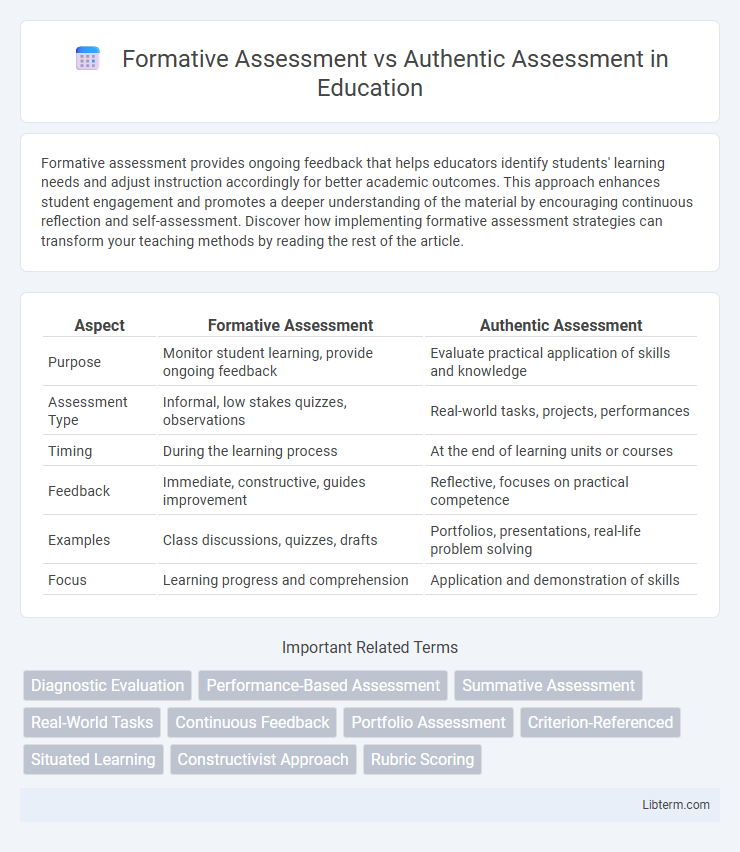Formative assessment provides ongoing feedback that helps educators identify students' learning needs and adjust instruction accordingly for better academic outcomes. This approach enhances student engagement and promotes a deeper understanding of the material by encouraging continuous reflection and self-assessment. Discover how implementing formative assessment strategies can transform your teaching methods by reading the rest of the article.
Table of Comparison
| Aspect | Formative Assessment | Authentic Assessment |
|---|---|---|
| Purpose | Monitor student learning, provide ongoing feedback | Evaluate practical application of skills and knowledge |
| Assessment Type | Informal, low stakes quizzes, observations | Real-world tasks, projects, performances |
| Timing | During the learning process | At the end of learning units or courses |
| Feedback | Immediate, constructive, guides improvement | Reflective, focuses on practical competence |
| Examples | Class discussions, quizzes, drafts | Portfolios, presentations, real-life problem solving |
| Focus | Learning progress and comprehension | Application and demonstration of skills |
Introduction to Formative and Authentic Assessment
Formative assessment involves ongoing evaluation during the learning process to provide immediate feedback and guide instructional adjustments, emphasizing skill development and knowledge retention. Authentic assessment measures students' abilities through real-world tasks and complex challenges that reflect practical application of skills, promoting deeper understanding and critical thinking. Both assessment types aim to enhance learning outcomes but differ in timing, purpose, and contextual relevance.
Defining Formative Assessment
Formative assessment is an ongoing process used by educators to monitor student learning and provide continuous feedback that can be used to improve teaching and learning outcomes. It involves a variety of methods such as quizzes, discussions, and observations that help identify student strengths and areas for growth before final evaluations. Unlike authentic assessment, which evaluates student performance through real-world tasks, formative assessment emphasizes timely interventions to enhance educational development during the learning process.
Understanding Authentic Assessment
Authentic assessment measures students' abilities through real-world tasks that reflect practical application and critical thinking, contrasting with formative assessment's ongoing feedback during learning. This approach emphasizes performance-based evaluation, encouraging deeper understanding and skill mastery aligned with actual challenges outside the classroom. By integrating authentic assessment, educators foster meaningful learning experiences that prepare students for professional and life situations.
Key Differences Between Formative and Authentic Assessment
Formative assessment focuses on ongoing feedback to improve student learning through quizzes, reflections, and discussions, while authentic assessment evaluates students' ability to apply skills in real-world contexts using projects, performances, and portfolios. Formative assessments are typically low-stakes and frequent, emphasizing process and progress, whereas authentic assessments are often high-stakes and comprehensive, measuring practical application and critical thinking. The key difference lies in formative assessment's role in guiding instruction and authentic assessment's emphasis on demonstrating mastery through meaningful tasks.
Objectives and Purpose of Each Assessment Type
Formative assessment aims to monitor student learning through ongoing feedback, enabling instructors to identify gaps and adjust teaching strategies to improve understanding and skills development. Authentic assessment focuses on evaluating students' ability to apply knowledge and skills in real-world or practical contexts, emphasizing critical thinking, problem-solving, and meaningful performance. Each assessment type serves distinct educational purposes: formative assessment promotes continuous improvement, while authentic assessment measures competency and readiness for real-life challenges.
Methods and Tools Used in Formative Assessment
Formative assessment methods include quizzes, observations, peer reviews, and interactive discussions that provide ongoing feedback to guide learning progress. Tools such as digital platforms like Kahoot, Google Forms, and formative assessment software enable real-time data collection and analysis of student understanding. These methods and tools prioritize continuous monitoring and adjustment of teaching strategies to improve student outcomes effectively.
Strategies and Examples of Authentic Assessment
Authentic assessment strategies emphasize real-world tasks such as projects, portfolios, and performance-based evaluations that demonstrate practical application of knowledge and skills. Examples include student presentations, case studies, simulations, and collaborative group work that mirror professional or everyday challenges. These approaches foster deeper learning by encouraging critical thinking, problem-solving, and reflection within meaningful contexts.
Benefits and Challenges of Formative Assessment
Formative assessment offers real-time feedback, helping educators tailor instruction to student needs, thus enhancing learning outcomes and increasing student engagement. It allows early identification of learning gaps but requires continuous effort from teachers and may demand more classroom time and resources. Despite its challenges, formative assessment fosters a supportive learning environment by encouraging student reflection and active participation.
Advantages and Limitations of Authentic Assessment
Authentic assessment offers the advantage of evaluating students' skills in real-world contexts, promoting critical thinking and practical application of knowledge. This method provides deeper insights into learners' abilities compared to traditional tests but can be time-consuming and challenging to standardize across different educational settings. Limitations include resource intensity and potential subjective grading, which may affect reliability and scalability.
Choosing the Right Assessment for Effective Learning
Selecting formative assessment enables ongoing feedback that guides student progress and instructional adjustments, fostering skill development and understanding. Authentic assessment emphasizes real-world tasks that demonstrate practical application of knowledge, improving engagement and transfer of learning. Effective learning results from aligning assessment types with specific learning objectives and student needs to balance skill mastery with meaningful application.
Formative Assessment Infographic

 libterm.com
libterm.com